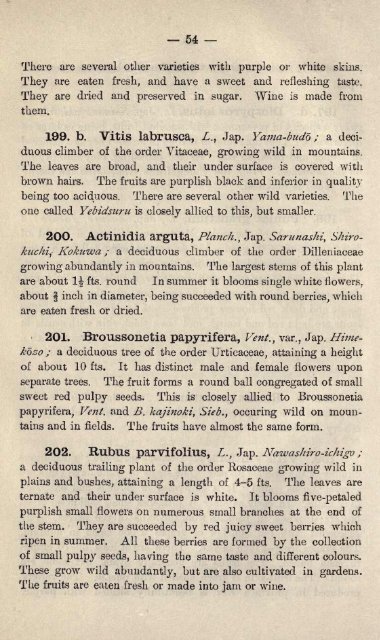Untitled - Library
Untitled - Library
Untitled - Library
You also want an ePaper? Increase the reach of your titles
YUMPU automatically turns print PDFs into web optimized ePapers that Google loves.
54<br />
There are several other varieties with purple or white skins.<br />
They are eaten fresh, and have a sweet and refleshing taste.<br />
They are dried and preserved in sugar. Wine is made from<br />
them.<br />
199. b. Vitis labrusca, .., Jap. Yama-bucto ; a deciduous<br />
climber of the order Vitaceae, growing wild in mountains.<br />
The leaves are broad, and their under surface is covered with<br />
brown hairs. The fruits are purplish black and inferior in quality<br />
being too aciduous. There are several other wild varieties. The<br />
one called Yebidsuru is closely allied to this, but smaller.<br />
200. Actinidia arguta, Planch., Jap. Sarunashi, Shirokuchi,-<br />
Kok2iwa ; a deciduous climber of the order Dilleniaceae<br />
growing abundantly in mountains. The largest stems of this plant<br />
are about \\ fts. round In summer it blooms single white flowers,<br />
about inch in diameter, being succeeded with round berries, which<br />
are eaten fresh or dried.<br />
201. Broussonetia papyrifera, Vent., var., Jap. Himekozo<br />
; a deciduous tree of the order Urticaceae, attaining a height<br />
of about 10 fts. It has distinct male and female flowers upon<br />
separate trees. The fruit forms a round ball congregated of small<br />
sweet red pulpy seeds. This is closely allied to Broussoneiia<br />
papyrifera, Vent, and B. hajinoki, Sieb., occuring wild on mountains<br />
and in fields. The fruits have almost the same form.<br />
202. Rtlbus parvifolius, L., Jap. Nawashiro-ichigo ;<br />
a deciduous trailing plant of the order Kosaceae growing wild in<br />
plains and bushes, attaining a length of 4-5 fts. The leaves are<br />
ternate and their under surface is white. It blooms five-petaled<br />
purplish small flowers on numerous small branches at the end of<br />
the stem. They are succeeded by red juicy sweet berries which<br />
ripen in summer. All these berries are formed by the collection<br />
7<br />
of small pulp} seeds, having the same taste and different colours.<br />
These grow wild abundantly, but are also cultivated in gardens.<br />
The fruits are eaten fresh or made into jam or wine.
















